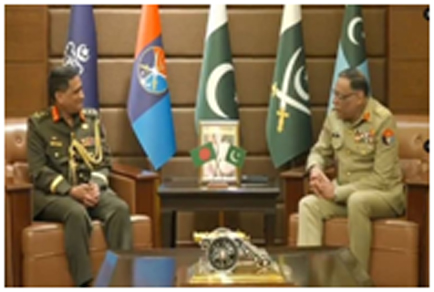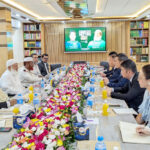
Online Desk: Pakistan’s Prime Minister Shehbaz Sharif met Chief Advisor Muhammad Yunus on two notable occasions—first at the UN General Assembly in New York in September 2024 and again during the D-8 summit in Cairo in December. Pakistan’s agricultural products and industrial machinery could fill gaps in Bangladeshi markets. Currently, bilateral trade stands at a modest $900 million, but experts believe it could surpass $5 billion with concerted efforts and preferential trade agreements. Economically, enhancing trade relations could lead to increased regional cooperation and markets for both countries.
Pak Army chief Gen AsimMunir reiterates the significance of joint efforts to promote peace and stability in South Asia. This unanimity of perception was reached during Gen AsimMunir’s meeting with General S M Kamr-ul-Hassan at the General Headquarters (GHQ) Rawalpindi. Both generals held extensive discussions on the evolving security dynamics in the region and explored further avenues for enhancing bilateral military cooperation, according to the Inter-Services Public Relations (ISPR). And most importantly, Pakistan and Bangladesh have cooperated on regional security issues, including counter-terrorism and border management.
The two countries have also discussed the possibility to build a pipeline to transport Gas from Bangladesh to Pakistan. This cooperation can help address Pakistan’s energy shortage and provide a new source of revenue for Bangladesh. While diplomatic and economic initiatives are crucial, the true test of this reset lies in fostering people-to-people connections. Cultural exchanges, educational collaborations, and eased visa processes are vital steps in this direction. The recent concert by Pakistani artist RahatFateh Ali Khan in Dhaka and scholarships for Bangladeshi students in Pakistan are symbolic yet meaningful gestures.
Needless to say, this historic Pak-BD rapprochement is seen as a means to evolve a regional tapestry based on a strategic trio–signifying a movement from divergence to convergence of interests, building bonds of cooperation and unity between Islamabad, Beijing and Dhaka. As for the China’s perspective, Bangladesh and Pakistan are key participants in Beijing’s Belt and Road Initiative infrastructure investments (BRI). Improved bilateral ties could facilitate greater connectivity and integration into regional trade networks, benefiting from Chinese. Such ties may enhance regional stability and influence the broader strategic landscape in South Asia.





